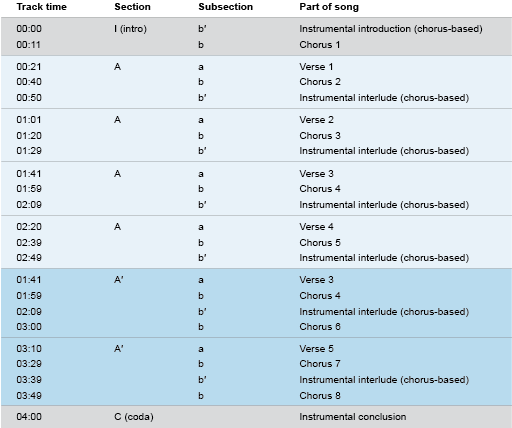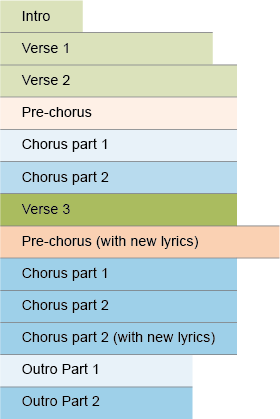15 Strategies for representing form
You have now encountered a number of ways of representing form. The first of these makes use of specialist terminology (e.g. verse, chorus, pre-chorus, coda/outro) and the second employs alphabetic designations (e.g. AABA, aa′). Musicians tend to use dedicated terminology for some song forms and alphabetic designations for others, but it would be entirely possible to use alphabetic representations across the board.
For example, earlier in this course, the structure of ‘Midnight Special’ was mapped out using specialist terms to designate sections, as shown in Table 14. The table identifies 20 sections in total, a multitude of parts that makes the form difficult to grasp at a glance. In such situations, it is often helpful to look for overarching structures that allow you to organise the detail in a more manageable way, for instance as a set of sections and subsections.
| Track timing | Section |
|---|---|
| 00:00 | Instrumental introduction |
| 00:11 | Chorus 1
|
| 00:21 | Verse 1 (Yonder come Miss Rosie ...) |
| 00:40 | Chorus 2 |
| 00:50 | Instrumental interlude
|
| 01:01 | Verse 2 (When you get up in the morning ...) |
| 01:20 | Chorus 3 |
| 01:29 | Instrumental interlude
|
| 01:41 | Verse 3 (If you ever go to Houston ...) |
| 01:59 | Chorus 4 |
| 02:09 | Instrumental interlude
|
| 02:20 | Verse 4 (When you get up in the morning ...) |
| 02:39 | Chorus 5 |
| 02:49 | Instrumental interlude |
| 03:00 | Chorus 6
|
| 03:10 | Verse 5 (I was standing at the station ...) |
| 03:29 | Chorus 7 |
| 03:39 | Instrumental interlude |
| 03:49 | Chorus 8
|
| 04:00 | Instrumental conclusion |
Figure 13 does just this. It contains the same details, but distinguishes two tiers of musical structure: sections, indicated by upper-case letters, and subsections, indicated by lower-case letters. The figure also employs the prime symbol to indicate when a section or subsection contains a varied version of music that occurs elsewhere. For example, in the Subsection column, the choruses are labelled b and the instrumental breaks are labelled b′. This acknowledges that the choruses contain sung material and the latter do not.
Similarly, the Section column differentiates A and A′ sections. Both A and A′ start with the pattern verse–chorus–interlude, but each of the sections marked A′ appends an ‘extra’ chorus. It is as though the A sections ‘thicken’ to become A′ sections as the song progresses. This thickening is also reflected in the shading of the figure (a darker shade of blue is used for the A′ sections than the A sections).
The two levels of analysis in Figure 13 allow a reader to keep track of the detail without losing the broader picture. Describing a piece of music as having the form abb′abb′abb′abb′babb′b is altogether too confusing; AAAA′A′ is much easier to grasp. In general, when analysing form, you should try to contextualise detail within a broader, simpler framework.
You may wish to listen to ‘Midnight Special’ again to see whether you can follow the broader structure outlined in Figure 13.
Although much of this course has focused on specialist terminology and alphabetical designations, almost all of the discussions of form have been accompanied by visual representations of one kind or another, some incorporating colour, including Figures 1, 2, 8 (‘hidden’ inside the Discussion for Activity 5), 9 and 13.
Figure 14 introduces a final image, for a song you have not yet encountered but may wish to investigate for yourself. The various parts of the form are colour coded: greens for verses and verse-like material, oranges for pre-choruses and blues for choruses and chorus-like material. The intensity of the colours reflects the loudness and softness of the music. The length, left to right, of the sections corresponds to their relative duration. As this suggests, a figure can convey all kinds of information about the musical object it represents.


